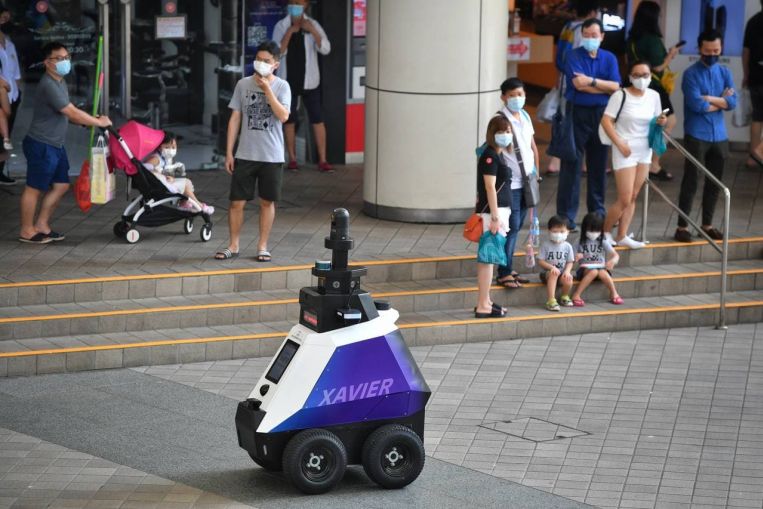[ad_1]
SINGAPORE – Rumbling around on four wheels as it patrols the town centre near Toa Payoh HDB Hub, Xavier encounters a man taking a puff from a cigarette in an area where smoking is not allowed.
Within seconds, video footage of this is sent to a command and control centre and fed into a video analytics system programmed to recognise the man’s posture, the outline of the cigarette in his mouth, and other visual indicators.
In a synthetic voice, a pre-recorded message blares out: “Please do not smoke in prohibited areas such as covered walkways.”
Acting as a tireless set of eyes, Xavier is an autonomous robot designed to weed out “undesirable social behaviours” that have been identified by public agencies here.
On patrol in the Toa Payoh Central neighbourhood as part of a three-week trial starting on Sunday (Sept 5), two of these robots will be on the lookout for errant smokers, illegal hawkers, motorcycle and e-scooter riders on footpaths, and gatherings that exceed the current limits on group sizes.
Equipped with cameras that have a 360-degree field of vision and can see in the dark, the robots will be able to alert public officers in real time to these offences. They will also be able to broadcast and display messages educating the public against such undesirable behaviour.
This is the first time that an autonomous robot is being used to patrol and survey a public area with high foot traffic to enhance public health and safety, said the five public agencies involved in the project.
The agencies are the Home Team Science and Technology Agency (HTX), National Environment Agency, Land Transport Authority (LTA), Singapore Food Agency and the Housing Board.
Xavier, developed by HTX in partnership with the Agency for Science, Technology and Research, will help to improve operational efficiency and reduce manpower needs for foot patrols, they said.
This is especially so for manpower-intensive operations such as surveillance of illegal hawkers.
The name Xavier, which means “new home” in Basque, is a nod to the robot being a refreshed version of the police’s Multi-purpose All-Terrain Autonomous Robots, or Matar, which have been deployed during large public events such as the National Day Parade, Marina Bay Countdown and Chingay.
Mr Cheng Wee Kiang, HTX’s robotics, automation and unmanned systems centre of expertise director, said at a media event on Sunday: “We gave this robot a new lease of life and expanded its capabilities.”
The differences between Xavier and its “policeman” cousin are a better suspension system that improves video stability and the analytics system developed by HTX.
Over four months, the system was fed publicly available information, such as images of smokers, to help it identify certain behaviours. It does not have facial recognition capabilities, said HTX.
The data collected and the analytics used can help public officers gain better insights and activate more resources if necessary, the authorities said.
For instance, it could provide information on new hot spots for errant active mobility device users and help LTA to focus its physical enforcement efforts to these areas.
During the trial, the robots will be used for education and deterrence, rather than enforcement, the authorities said. The aim is to collect data to improve the analytics system and fine-tune any kinks.
“After we analyse the results, we will make the necessary arrangements to destroy the data,” said HTX’s Mr Cheng.

To enable it to safely navigate the heartland, Xavier is fitted with sensors so it can avoid both stationary and dynamic obstacles, such as pedestrians and vehicles, along its pre-configured patrol route.
In Toa Payoh, the robots will be deployed along two routes, each 1km to 1.5km long, every day except Saturday, from 8am to 10am, noon to 2pm and 5pm to 7pm.
Officers at the command and control centre can monitor and control multiple robots simultaneously.
The officers can also respond to any incidents remotely through Xavier’s two-way intercom.
[ad_2]
Source link






Leave A Comment
You must be logged in to post a comment.